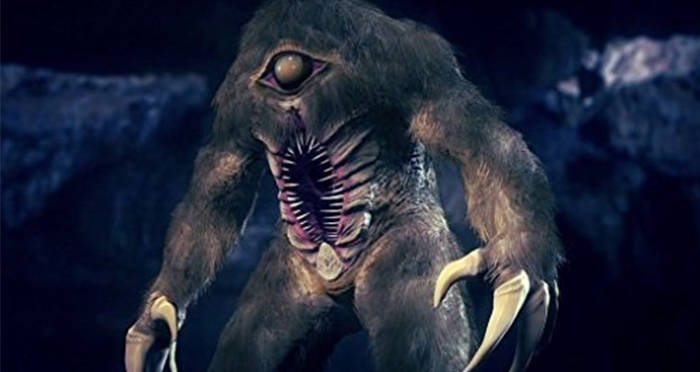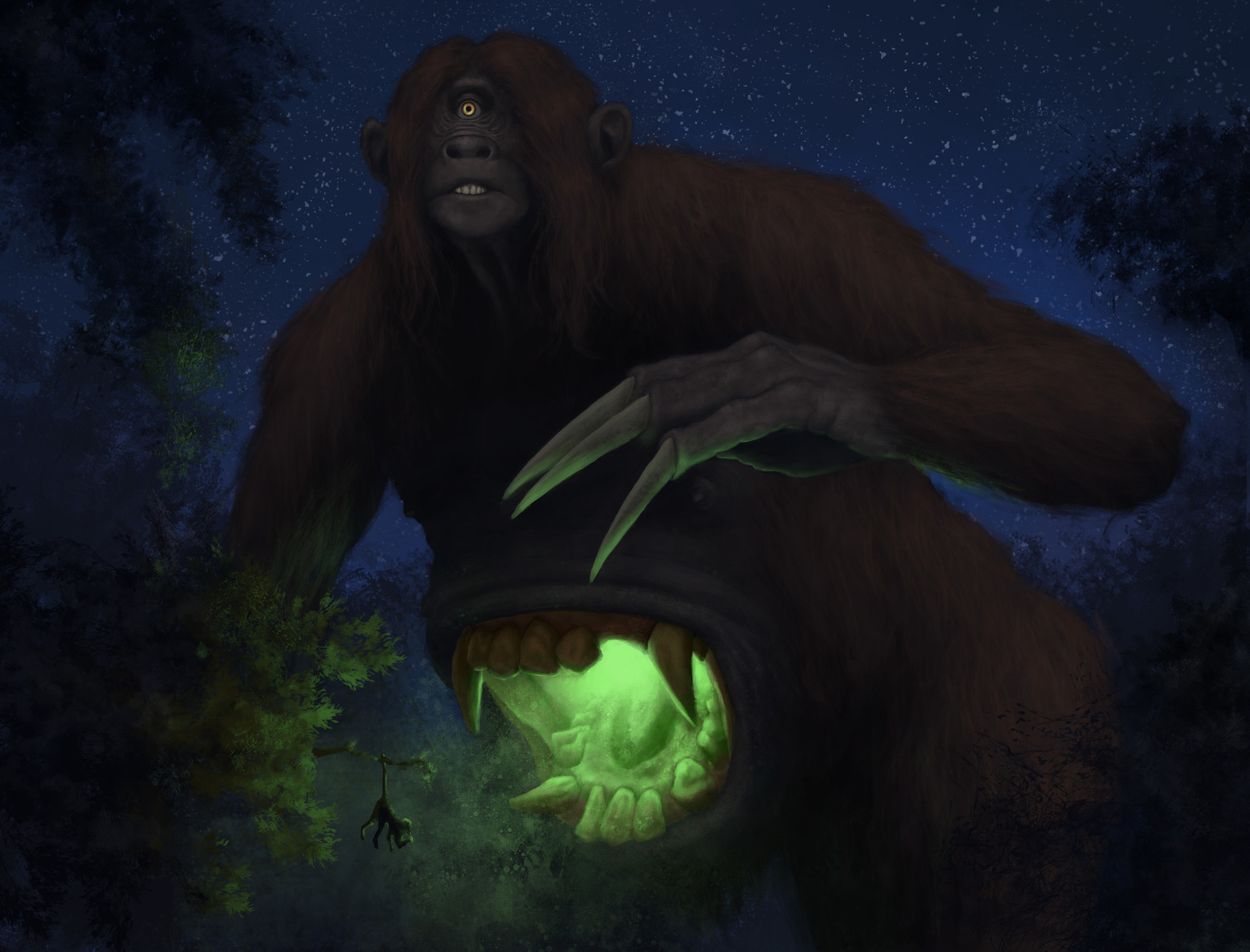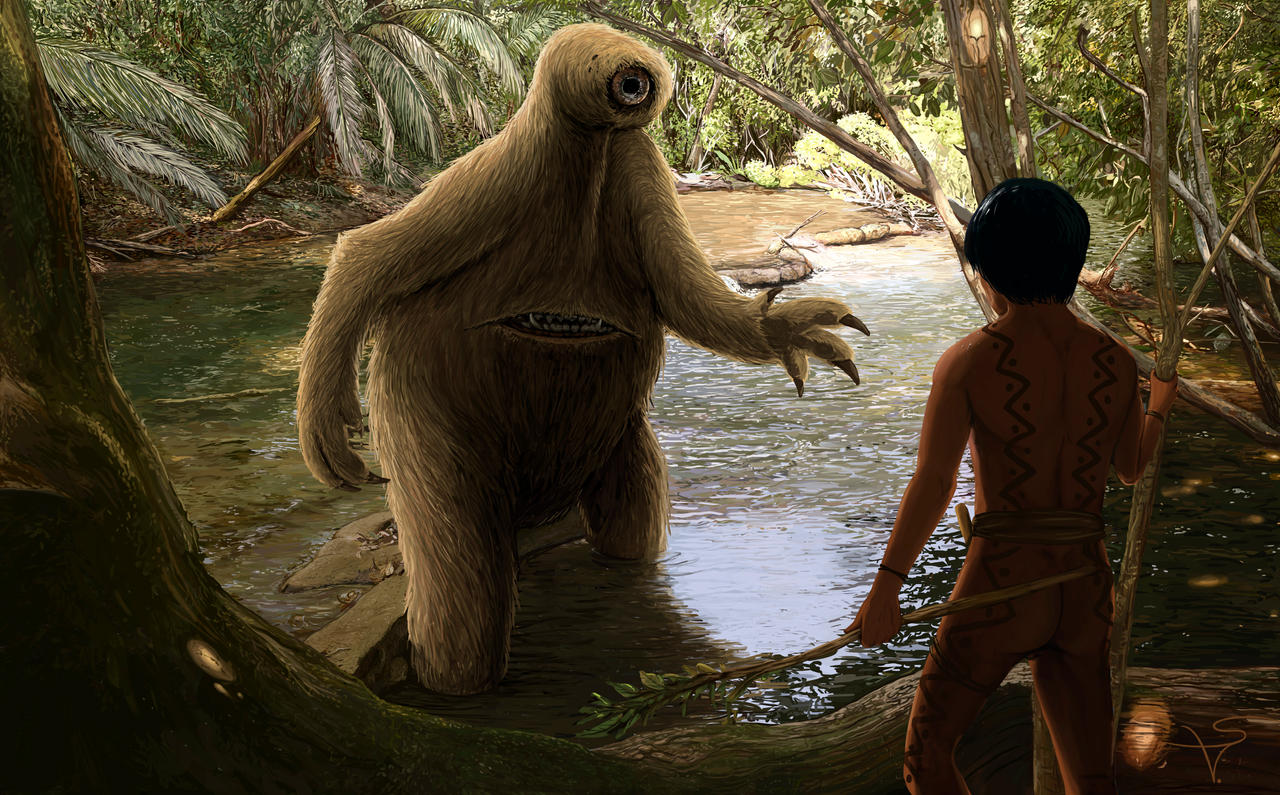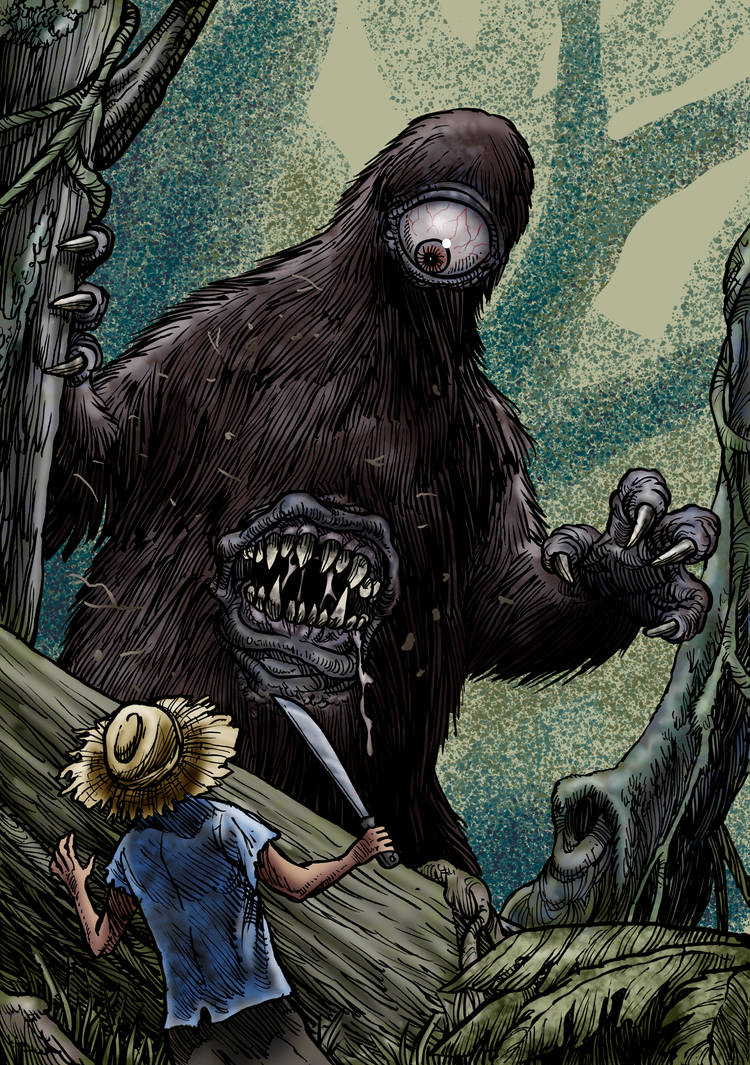Legends abound about legendary creatures from all over the world, some lovely and fun, such as fairies, and others vicious and deadly, such as yowies. Many people believe in these creatures and claim they have seen them firsthand inside their respective civilizations.
Sloths are often depicted as peaceful, slow-moving creatures who enjoy hanging from trees and meticulously consuming flowers. A vicious sloth is tough to imagine.
The Isnashi, also known as the mapinguari or mapinguary, is a cryptid that lives in the Amazon rainforests of Brazil and Bolivia. “the fetid beast” or “the roaring monster.” two frequent translations. It is said to resemble a red-furred ground, sloth-like creature.
The mapinguari, on the other hand, is massive, reaching seven feet in length when standing on its rear legs, which it does on occasion despite being expected to move on all fours. The unlucky person who is viewing it when it achieves this position may see its second mouth, which is located on its belly.
It gets weirder depending on who delivers the description. It is said to have only one eye focused on its head, and its thick skin resembles that of a crocodile, causing arrows to bounce off it. Its backward-facing foot has sharp claws.
Unlike the common sloth, mapinguaris are said to be voracious carnivores who will eat anything that moves, including large herds of cattle. Regardless, no human has ever been reported to have been eaten by the beast. However, this could be due to the mapinguari’s odor, a foul-smelling warning that is supposed to cover a huge radius and be so intense that it can knock someone out.
Mapinguari Mythological Sloth Monster

The mere thought of the mapinguary, the Amazon’s huge slothlike creature, sends chills down the spines of nearly everyone who lives in the world’s biggest rainforest. Skeptics claim that it is nothing but a legend. Or, as many who claimed to have seen it alleges, it may be real.
For years, legends have circulated about a massive, terrible beast lurking in the deep foliage of the Amazon jungles in South America. It resembles an ape or even a huge sloth at first view. It moves slowly, but it isn’t a sloth at all upon closer inspection.
It was given the name “mapinguari” through time, which means “roaring animal” or “foetid beast.” As it searches for food, this raging beast roams the South American jungles, knocking down foliage and trees with its formidable claws and leaving a path of destruction in its wake.
Even though the presence of the mapinguari is frequently ignored as folklore or another urban legend, there’s real scientific proof that this narrative is founded on fact. The description is based on the enormous ground sloth, an elephant-sized sloth that existed in South America until the end of the Pleistocene epoch and was formally named “Megatherium.”
The monster is reported to have two eyes in some places, but only one in others, similar to the Cyclops of Greek mythology. According to legend, the monster’s belly has a gaping, smelly mouth through which it swallows humans who happen to cross its path.
“Often, the mapinguary gets revenge on people who transgress, who go where they shouldn’t go or harvest more animals or plants than they can consume, or set cruel traps.”
Márcio Souza, a well-known Brazilian author, and dramatist who resides in Manaus, in the center of Amazon, and frequently incorporates Amazon history and folklore into his works, remarked as much.
There are several indigenous tribes in the Amazonian jungle, many of whom have never met, and they all believed in the mapinguari, use their own names for it, and personal tales of it. Geraldo Karitiana, a member of the Karitiana tribe, told the New York Times about his experience hunting in the jungle near “the cave of the mapinguari,” as his tribe refers to it.
Whenever a hunter or woodsman gets trapped in the jungle, he usually blames the Curupira, a naughty red-haired elf with backward-facing feet who enjoys creating trails that lead people astray. When a skilled navigator mysteriously vanishes or drowns in calm seas, it is frequently attributed to the iara, a siren and mermaid hybrid.
Scientists have discovered remains of the huge Megatherium sloth going back over 11,000 years, demonstrating that it previously existed. Even though they’ve been extinct, some people seem to believe that the mapinguari’s recorded sightings are proof that the giant ground sloth is still alive and well deep in the Amazon jungle. Of course, it’s possible that the narrative, while historically accurate, was exaggerated as it was passed down through the centuries, resulting in the well-known urban legend of the terrifying mapinguari.
What do zoologists think about Mapinguari?

Many cryptozoologists are interested in stories of this species, while others have rejected it as a folk tales creature or a lengthy folk memory of the Pleistocene-era huge beasts that formerly roamed South America. According to certain theories, the mapinguari was thought to be a big ape, a large ground sloth, or perhaps a unique giant anteater, Myrmecophaga tridactyla. It may appear on a TV culinary program to be an unusual meal, but it isn’t. According to Brazilian naturalist David Oren, it is a massive, ancient underground sloth that still lives in the Amazon basin’s wooded terrain.
Dr. Oren’s fieldwork as the head of zoology at the Emilio Goeldi Natural History Museum in the 1990s exposed him to various mapinguari legends. Dr. Marc van Roosmalen, South America’s preeminent new mammal discoverer, had also heard of the creature and was fascinated.
While some cryptozoologists believe the stories are about a massive ape, Oren was impressed by how tales of the red-haired beast matched what we know about mylodontid ground sloths. Ground sloths came in a variety of species.
It is occasionally, but not always, described as possessing extraordinary features such as a single eye and a mouth in its belly. According to Oren, the solitary eye is more commonly seen in folklore than in first-hand encounters. It is most notable for being bullet and arrow proof until hit in the head’s navel, eye, mouth, or other parts. This invulnerability is frequently attributed to the animal’s hair or thick, crocodile-like skin.
Eremotherium laurillardi, the biggest, grew to be the size of a good elephant, weighing approximately three tonnes. Some South American animals were unquestionably hunted by human ancestors and are thought to have existed just 8,500 years ago. Also in favour of a sloth identity: there is no evidence in the New World for any ape even close to the size of Homo sapiens, except the size of a ground sloth.
The basic size and look of the mapinguari accounts resemble certain ground sloths, as do footprints with clawed toes pointing inward and the color.
As they were known at the time, David Oren explained how each of the mapinguari’s traits was compatible with a human-sized mylodontid ground sloth in a 1993 publication for Goeldiana Zoologia. Genetic tests from desiccated ground sloths are almost exclusively reddish in color.
They are said to have moved with their claws pointed inwards, which would lead to legends of backward feet since the odd curve would cause people to read the footprints the opposite way around, and prehistoric ground sloth traces have been mistaken for enormous human footprints in the past.
Oren set out on his first quest for the mapinguari in the Brazilian rainforest in 1995. This may seem like an odd endeavor for a Harvard graduate, but Oren discovered the eyewitness testimonies and eleven-inch tracks interesting.
He was well aware of the media attention that would precede the finding of such a magnificent creature — attention that’d lead to further protection for the rainforest’s vulnerable ecosystem. He has put in a tremendous amount of work to the project, enduring multiple difficult excursions and a thicket of skepticism from his peers. He’s also recruited, several helpers.
One of them is journalist Marcelo Volcano, who tracked down a fresh witness in the state of Matto Grosso in 1999 who reported a monster with long reddish hair, towering over five feet tall on its hind legs, and smelling foul. Although his description matches nothing other known in Brazil, the man is familiar with typical sloths and observed no similarities.
The mapinguari is said to have the way of making people dizzy, as well as a second “mouth” in its stomach, which Oren believes is a small gland that explains the former.
The majority of scientific opinion is against Oren. Professor Paul Martin, a megafaunal extinction expert, is among many who believe Oren is wasting his time. Oren changed his mind, claiming that the mapinguari was a megalonychid ground sloth rather than a mylodontid: megalonychids possessed frontal caniniform teeth, which were practically unique among ground sloths.
Cryptozoologists such as Bernard Heuvelmans, Ivan T. Sanderson, and Loren Coleman have long thought of the mapinguari as a bipedal primate akin to an ape, comparable to other South American cryptids such as the curupiru or the didi of Guyana, which are occasionally confused. Although this notion is no longer as prevalent as it once was, cryptozoologists such as Coleman maintain it, pointing out that certain observations cannot be attributed to ground sloths.
Pat Spain heard a slowed-down sloth cry in the jungle during Pat Spain’s inquiry into the kida harara. Spain suspected he received a vocal response that sounded like his modified sloth cry. Eyewitness Geovaldo was shown photographs of a variety of South American and African creatures. Geraldo identified the South American fauna. Spain suspected he received a vocal response that sounded like his modified sloth cry. Eyewitness Geovaldo was shown photographs of a variety of South American and African creatures. Geovaldo identified the South American fauna.
Is mapinguari more than a myth?

Numerous scientists have struggled to disprove the existence of this massive ground sloth, despite their best attempts. Despite the creature’s far-fetched description, many academics believe it is a relative of the Megatherium, a massive ground sloth.
The Megatherium, which was described as traveling on four legs but able to stand on its hind legs and reaching at least nine feet in length, is thought to have gone extinct sometime around the 16th century. It was claimed to have possessed enormous claws that looked to be pointing backward, which is used to dig up plants. Massive smell glands were discovered on its stomach, which may have been misinterpreted for a second mouth. Perhaps it explains the creature’s unpleasant stink. The Megatherium, unlike the mapinguari, was reported to be a vegetarian.
The Amazon is the exception to the world’s abundance of unusual, fascinating, and fear-inducing species. Of course, no one knows what the mapinguari is, but like many legendary monsters, the mapinguari’s bad reputation and odour accompany it. Jungle explorers would be well served to flee at the first whiff of something foul, as tribal chief Domingos Parintintin said, “the greatest thing to do if you encounter one is climb trees and hide.” While you’re up there, you may as well snap a few photos.
Every two days, a new species is discovered in the Amazon, says to environmental writer Ian Johnston. The extraordinary rate of new discoveries demonstrated that scientists had barely scraped the top of all the ‘amazing species’ that reside there. If the Amazon lasts long enough to share its secrets, the mapinguari may be next on the list.
Is there any physical evidence of mapinguari

Despite repeated attempts, searches for reliable physical proof have been fruitless, since the mapinguari’s existence is based solely on anecdotal evidence. Ornithologist David Oren is one of the numerous scholars seeking to locate proof of the mapinguari’s existence.
During his several journeys, he gathered a variety of materials, some of which were eventually identified as agouti fur, anteater dung, and inconclusive castings of footprints. Nonetheless, Oren believes the creature to be genuine, albeit elusive and now exceedingly rare and avoids human interaction whenever possible.
Preserved old skin samples from the late 19th century showed hard dermal ossicles, little fragments of bone in the epidermis of dinosaurs, and alligators that defended them from predators, which might explain the ground sloth’s alleged bulletproof hide. Such skin would probably be bullet and arrow proof.
Oren has gathered more than simply anecdotal evidence. Oren has captured film of clawed trees, recorded what he thinks are the creature’s minute-long deafening roars, and created molds of big circular footprints with claws facing backward. He also gathered hair and 22 pounds of excrement, which are being analyzed, hoping to compare the DNA in the hair to DNA from living sloths’ blood.
The descriptions are so strikingly identical that it can’t be a coincidence. Some cite the fact that practically every Amazonian tribe, including those that have never met, has a term for the monster.
Indeed, until 1997, while he was conducting research among the Machiguenga people of Peru’s far western Amazon, Glenn Shepard Jr., an American ethnobiologist was among the skeptics who deemed the mapinguari “a rustic tale.” When he asked tribal members about the surrounding animals, they all reported a terrifying sloth-like monster that lived in a mountainous, wooded location in their territory.
There’s still plenty of area for a giant sloth to stroll about.
